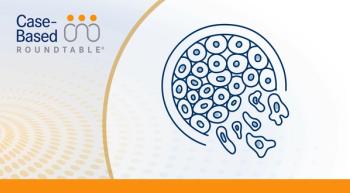
MCL35 Assay Stratifies Risk in Patients With Mantle Cell Lymphoma
A new multi-analyte prognostic assay has demonstrated the potential to risk-stratifying patients with mantle cell lymphoma based on the particular molecular signature of an individual patient’s cancer, according to a new study.
A new multi-analyte prognostic assay has demonstrated the potential to risk-stratifying patients with mantle cell lymphoma (MCL) based on the particular molecular signature of an individual patient’s cancer, according to a new study.
The findings could eventually help improve care for patients by MCL by allowing clinicians to more accurately tailor care to patients. The study was published in the
MCL therapy has significantly improved in recent years with the approval of novel agents, but corresponding author Lisa M. Rimsza, MD, of the Mayo Clinic, and colleagues, noted that the response to these new therapies is widely variable from patient to patient. That is in large part because most treatment plans are arrived at by taking into account broad measures like a patient’s general health, age, and perceived ability to tolerate regimens.
That status quo changed to some extent with the 2008 introduction of the MCL International Prognostic Index (MIPI), which uses a mix of clinical factors and lab results to stratify patients. A variation of that index, the biologic MIPI (MIPI-b) uses immunohistochemical staining for the antigen Ki-67, a marker for cell proliferation that Rimsza and colleagues said can add value to the MIPI. Still, the investigators said such tools still have significant room for variance.
“[M]ethods using clinical data, tumor morphology, and/or immunohistochemistry are highly subject to inter-observer and inter-laboratory variability,” they said.
However, Rimsza and colleagues have developed what they believe is another, more precise method of risk-stratifying patients. The Lymphoma/Leukemia Molecular Profiling Project research consortium was able to identify a proliferation signature using targeted “LymphoChip” microassays that was later enhanced and developed into a clinically compatible assay known as MCL35. The tool includes 17 informative genes and 18 house-keeping genes. The 17 informative genes include 13 that correspond positively with proliferation and thus with poor survival outcomes; the other 4 correspond negatively with proliferation and suggest better survival outcomes.
Having developed the tool, Rimsza and colleagues sought to evaluate its suitability in a clinical laboratory and its effectiveness compared to the Ki-67 proliferation marker.
Working with the Molecular Diagnostics-Arizona Laboratory, the assay was assessed for accuracy, sensitivity, specificity, use in acid-decalcified bone marrow core biopsies, fixatives, lower limit of RNA input, quality metrics, and other laboratory parameters.
The investigators found that the MCL35 assay is a “robust technique with outstanding reproducibility.”
“The MCL35 assay demonstrated excellent concordance with the gold standard signature defined by Affymetrix gene expression profiling, thereby validating the accuracy of the assay,” Rimsza and colleagues wrote in the published report.
They said samples run multiple times by different users yielded similar results with only small standard errors. The assay was found to be capable of robustly assigning risk category even with inputs as low as 50 ng of formalin-fixed paraffin-embedded (FFPE) sample–derived RNA.
On the other hand, Rimsza and colleagues could not verify the accuracy of the assay when analyzing acid-decalcified core biopsies. The investigators said only 4 of 10 biopsy attempts resulted in successful analysis, and all 4 of those successful biopsies led to high-risk MCL35 scores.
“Caution is therefore advised in the use of bone marrow core biopsies for the MCL35 assay, since the proliferation of the background hematopoietic cells is so high that it may dominate the results,” they said.
The authors said they were unable to assess MCL35 in other types of non-nodal samples because they lacked clinical annotation, though they said a previous publication suggested the assay is accurate and correlated with overall survival.
In the current study, the investigators compared their risk-stratification results using the MCL35 assay with Ki-67 assays. Overall, the agreement between the 2 tools was just 37%. Further analysis suggested the Ki-67 tool errs on the side of a higher risk category, whereas the MCL35 tool tended to identify more patients as lower risk.
“Since the MCL35 assay is a multiplexed assay based on the weighted expression of 17 proliferation genes rather than a single marker, it may provide a more accurate reflection of the complex multifaceted/multifactorial nature of tumor biology, and, as shown in prior publications, is highly reproducible as compared with other methods,” they wrote.
The investigators concluded by stating that existing data support molecular signatures assessed by digital gene expression profiling as an “excellent choice for use in clinical trials wherein the relationships between biomarkers and patient outcome may lead to clinical practice changes.”
The study authors said the MCL35 tool has been launched as a laboratory-developed test and can be used in retrospective analysis of clinical trials and potentially in prospective trials as well; the assay has already been used in one such trial, and others are underway.
Reference:
Ramsower CA, Maguire A, Robetorye RS, et al. Clinical laboratory validation of the MCL35 assay for molecular risk stratification of mantle cell lymphoma. J Hematop. 2020;13(4):231-238. doi:10.1007/s12308-020-00418-4








































